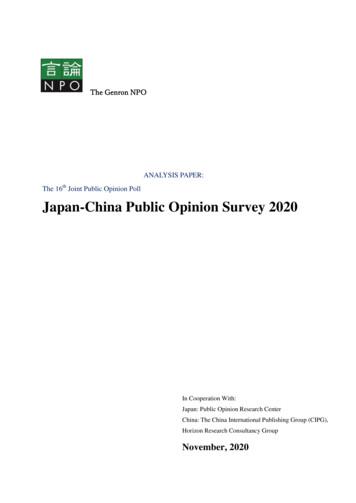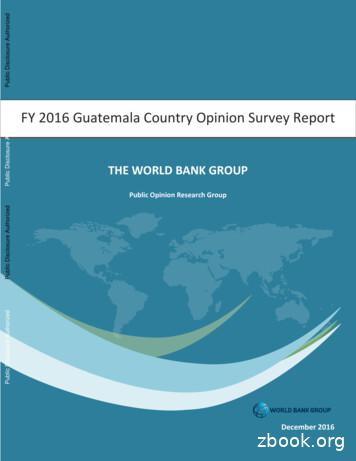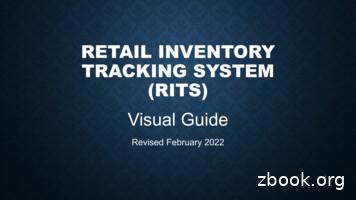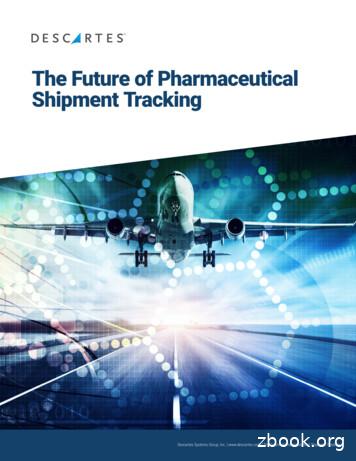Tracking Public Opinion About Unsupported Narratives In .
Tracking public opinion aboutunsupported narratives in the2020 Presidential electionWave 3, 2-13 Oct. 2020Observatory onSocial Media (OSoMe)Indiana University-Bloomington
Observatory on Social Media (OSoMe), Indiana University-BloomingtonTracking public opinion about unsupportednarratives in the 2020 Presidential electionWave 3, 2-13 Oct. 2020Indiana University’s Observatory on Social Media (OSoMe) continues to track widely circulated butunsupported narratives throughout the 2020 presidential election season, with the goal to assess thepublic’s awareness of them, the extent to which they are believed, and whether a person’s politicalleanings, media use, and personal traits are related to vulnerability to these narratives.This is a report on our third wave of data, collected from 2 to 13 October 2020. The reports from Waves 1and 2 can be found at http://osome.iu.edu/research/survey/.NarrativesWe showed respondents five screenshots from social media that represented trending but factuallyunsupported narratives, and asked them if they had encountered the narratives, or similar ones, on socialmedia or the internet. In addition to asking whether respondents had encountered each narrative we alsoasked to what extent they believed the narratives.In Wave 3, we tracked two narratives that were also assessed in Waves 1 and 2. These were:Joe Biden is not mentally fit to be President. 1Mail-in ballots cause election fraud. 2We also added three additional narratives in Wave 3:The Bill & Melinda Gates Foundation sponsored a vaccine that causes polio in Africa. 3QAnon is correct that pedophiles and cannibals currently serve in US government positions. 4Face masks increase the risk of spreading and contracting Covid-19. 51 ceptively-edited-to-make-him-appear-lost/2 m-thousands-are-conspiri/3 t-bill-gates-an/4 on-pizzagate-conspiracy-theories-co-opt-savethe/5 nts-the-science-behind-face-masks/6 st-presidential-biden-trump/02Tracking public opinion about unsupported narratives in the 2020 Presidential election
Observatory on Social Media (OSoMe), Indiana University-BloomingtonResultsFigure 1 shows results for the two narratives (Biden’s cognitive state and mail-in voting) that weretracked across Waves 1, 2, and 3. Both narratives continue to be widely seen, in increasing frequencyacross the almost two-month period of data collection for the three waves (from 43% for the Biden storyto 48% in the third wave). Yet, despite growing awareness of the Biden narrative, belief in its truth-valuedecreased steadily over time, from 46.1% to 45% and 40.6%. This may reflect Biden’s performance inthe first presidential debate. Several surveys shortly after the debate showed that viewers perceivedBiden not only as performing better in the debate than Trump, but also that Biden had a better commandof important issues than the president.6 Conversely, belief in the mail-in ballot narrative is growingstronger, first going down slightly from 46.4% to 45% in wave two but then up to 50%, as the Trumpcampaign and political operatives continue to raise questions about the legitimacy of mail-in ballots.Figure 1 Responses to unsupported narratives tracked across Wave 1, 2, and 3Figure 2 shows results for narratives included only in Wave 3. There were high levels of awarenessabout all three narratives, with 34.8% to 38.2% of participants saying they had encountered them.Belief in their truth value varied considerably across narratives. About 44% thought that QAnon storiesabout pedophiles and cannibals could be true. Over 36% thought that the Bill and Melinda GatesFoundation could have had a role in causing polio through vaccination. Almost 23% thought there is apossibility that mask-wearing facilitates infection with the coronavirus. (See results about othernarratives from Waves 1 and 2 in our earlier reports.)03Tracking public opinion about unsupported narratives in the 2020 Presidential election
Observatory on Social Media (OSoMe), Indiana University-BloomingtonFigure 2 Responses to unsupported narratives in Wave 3Comparison by voting preferenceA number of studies have shown that widely diffused but unsupported narratives appear to originatemore often from right- than left-of-center sources (see examples in Grinberg et al., 20197, Luceri et al.,20198, and Lewis & Marwick, 20179).10 F or this reason we looked at the issue through the lens ofpresidential candidate preference. As seen in Figure 3, each narrative has more adherence among thosepreferring the Trump/Pence ticket than among supporters of Biden/Harris. As we reported in Wave 2,undecided voters and those expressing preferences for third-party candidates fall somewhere in between.Differences are especially stark for the highly politicized issues of Biden’s cognitive state (Trumpsupporters, 73.9%; Biden supporters, 17.7%) and mail-in ballots (Trump supporters, 74.4%; Bidensupporters, 36.4%), reflecting the polarized nature of the current political environment in the UnitedStates.Figure 3 Belief in the truth-value of narratives by candidate preference04Tracking public opinion about unsupported narratives in the 2020 Presidential election
Observatory on Social Media (OSoMe), Indiana University-BloomingtonUnsupported narratives and open-mindednessIn recent years researchers have used a number of questions to investigate how an actively open-mindedthinking style about evidence (AOT-E) can influence a person’s beliefs, values, and opinions.11 In ourstudies we tested if open-mindedness puts a person at greater or lesser risk for believing unsupportednarratives. To do that, we asked participants to use a 7 -point scale to indicate their level ofagreement/disagreement with statements such as: "I believe that loyalty to one’s ideals and principles ismore important than “open-mindedness.”" Figure 4 shows results for those who scored above and belowthe mean on this item. It is clear that principled thinkers are almost twice as likely to believe all five of theunsupported narratives. One might intuitively think that open-minded thinkers would be more vulnerableto entertain suggestion, rumor, and unsupported information – and that might very well be the case. Butwhen it comes to evaluating information for its believability, open-minded thinkers may be more guidedby evidence and perhaps less vulnerable to misinformation than principled thinkers.Figure 4 Beliefs in the truth value of narratives among principled versus open-minded thinkers7 Grinberg, N., Joseph, K., Friedland, L., Swire-Thompson, B., & Lazer, D. (2019). Fake news on Twitter during the 2016 US presidential election.Science, 363(6425), 374-378.8 Luceri, L., Deb, A., Badawy, A., & Ferrara, E. (2019, May). Red bots do it better: Comparative analysis of social bot partisan behavior. In CompanionProceedings of the 2019 World Wide Web Conference (pp. 1007-1012).9 Lewis, R., & Marwick, A. (2017). Taking the red pill: Ideological motivations for spreading online disinformation. Understanding and addressing thedisinformation system. Retrieved df.10 This report features narratives more believed on the right. Our Wave 2 report looks at an example of a narrative with more credence on the left(relating to Trump’s supposed stroke), and our upcoming Wave 4 report looks at COVID narratives that seem to have a left origin.11 Baron, J. (1993). Why teach thinking? An essay. Applied Psychology: An International Review, 42, 5Tracking public opinion about unsupported narratives in the 2020 Presidential election
Observatory on Social Media (OSoMe), Indiana University-BloomingtonMethodologyThis is the third of a six-part series of reports tracking the diffusion of misinformation in the 2020 U.S.presidential election campaign period. Data in this wave were collected from an online panel of Americanadults, recruited by Qualtrics. Data were collected from 2-13 October, 2020. The sample size was 587(margin of error 4%). Forty five percent of participants were female. The average age was 46.5 (SD 19),with a range of 18 to 96. The sample was 57.1% white, 14.3% Black, and 12.4% Latina/Latino.OSoMeThe Observatory on Social Media is a joint project of the Network Science Institute (IUNI), the Center forComplex Networks and Systems Research (CNetS) at the Luddy School of Informatics, Computing, andEngineering, and the Media School at Indiana University.For more les/W3 data for public.pdfosome.iu@gmail.com@OSoMe IU@OSoMeIU06Tracking public opinion about unsupported narratives in the 2020 Presidential election
QAnon is correct that pedophiles and cannibals currently serve in US government positions. Face masks increase the risk of spreading and contracting Covid-19. ˆ 02 Tracking public opinion about unsupported narratives in the 2020 Presidential election Observatory on Social Media (OSoMe), Indiana University-Bloomington
the GUID Partition Table (GPT) scheme, if your Windows installation. . Pro4 Motherboard and a TPM and Windows 10 says Secure Boot Unsupported. . 10/8/7 system, follow the useful solutions to fix UEFI boot on Windows 10. windows loader windows loader unsupported partition table fix Windows Loader 1.9.7 By Daz Windows Loader 1.9.7 By Daz .
Japan-China Public Opinion Survey 2020 In Cooperation With: Japan: Public Opinion Research Center China: The China International Publishing Group (CIPG), Horizon Research Consultancy Group November, 2020 The Genron NPO . The Genron NPO 2020 THE 16TH JAPAN-CHINA PUBLIC OPINION POLL 2
Object tracking is the process of nding any object of interest in the video to get the useful information by keeping tracking track of its orientation, motion and occlusion etc. Detail description of object tracking methods which are discussed below. Commonly used object tracking methods are point tracking, kernel tracking and silhouette .
World Bank Group Country Opinion Survey 2016: Guatemala Acknowledgements The Guatemala Country Opinion Survey is part of the County Opinion Survey Program series of the World Bank Group. This report was prepared by the Public Opinion Research Group (PORG) team led by Sharon Felzer (Senior Communications Officer, Head of PORG), Jing Guo,
[P0F] @ Reta1Ier Inventory Tracking system Visual Guide Retailer Inventory Tracking system Visual Guide r,nps.//comptroller.texas gov/taxeS1alcot1oltdocslr1ts V1Sual-gu . de pdf 2012J08/15 Texas Cigarette Tax Stamp Onhne Order Form Fill out Chis form 1f you are a Texas business operator and you need co order cigarette tax stamps.File Size: 2MBPage Count: 39Explore furtherRetail inventory tracking system" Keyword Found Websites .www.keyword-suggest-tool.comAlcohol Reporting - Texas Comptroller of Public Accountscomptroller.texas.govRetailer Inventory Tracking Systemmycpa.cpa.state.tx.usRetailer Inventory Tracking System - Helpmycpa.cpa.state.tx.usTexas Comptroller of Public Accountsdata.texas.govRecommended to you b
Animal tracking, pallet level tracking Item / Case level tracking Item / Case level tracking, pallet tracking 2.1.2 Active RFID Tags Active RFID tags possess their own internal power source that enables them to have extremely long read ranges. Typically, active RFID tags are powered by a battery which lasts a few years depending on the use case.
2. Deploy common tracking technology and open network connectivity: Ensure tracking across the entire logistics chain despite the numerous hand-offs 3. Automate data capture: Improve data accuracy and timeliness, reduce tracking labor 4. Create a closed-loop process for reusing tracking tags: Reduce tracking costs and improve sustainability
Scrum for Video Game Development Mike Cohn - background Mountain Goat Software, LLC 1 2 Wednesday, January 23, 2008























